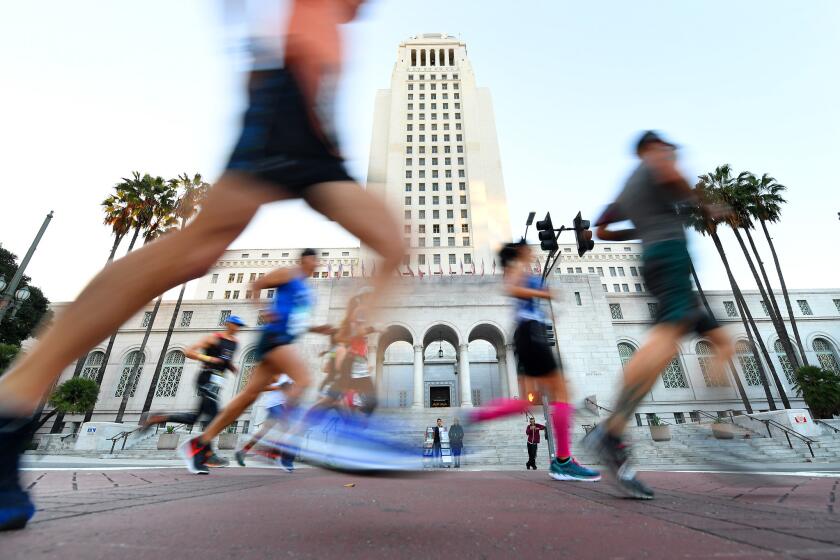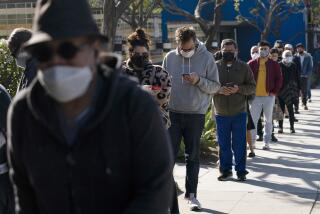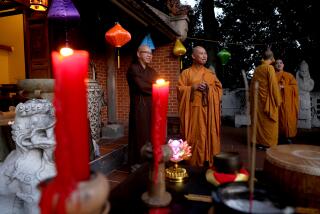Canceled by coronavirus: Bay Area cracks down on gatherings, concerts and commutes
- Share via
SAN FRANCISCO — The efforts to battle coronavirus in California have taken a dramatic turn, with public health authorities in Northern California asking the public to make sacrifices that will cause hardship on everyday life on a scale not seen in generations.
Disruptions that were unimaginable months ago became real almost immediately. San Francisco’s St. Patrick’s Day Parade was postponed. San Francisco Symphony concerts were scrapped. Stanford University moved classes online. Silicon Valley companies ordered employees to work from home. Heeding San Francisco’s call to cancel large gatherings, such as concerts, sporting events and conventions, even a volunteer tree planting gathering for Arbor Week was pulled.
And the largest school district in Northern California, the Elk Grove Unified School District, canceled class and sports games through Friday after a family associated with the Elk Grove Unified School District was exposed to the virus and placed on quarantine to see if they were infected and would get sick.
Cancel or postpone all non-essential gatherings and in-person meetings, some of the recommendations said. Work from home if you can, especially if you’re over the age of 60 or have medical conditions such as heart disease, lung disease, diabetes, kidney disease or a weakened immune system. Suspend non-essential employee travel. Try to keep workers one arm’s length away from each other. Stagger start and end times at the office to keep people away from each other. Don’t require a doctor’s note for sick workers. Stock up on your medications.
The tips also went down to personal habits: Use a paper towel to press the elevator button and door handles. Stop shaking hands. Stay home if you’re sick. And, in particularly direct language from the San Mateo County health officer: “Under all circumstances, stop touching your face, eyes, nose, or mouth with your unwashed hands.”
In Southern California, authorities decided to allow the Los Angeles Marathon to proceed Sunday as scheduled. But health officials did urge spectators to keep 6 feet away from strangers, the maximum distance at which droplets loaded with virus from an infected person’s cough or sneeze can fly before falling to the ground.
As the Los Angeles Marathon approaches, some athletes and city residents are worried that the race could be a hotbed for the spread of the novel coronavirus.
Los Angeles County health officials have tried to urge calm as well as safety. There are now 14 cases in L.A. County, with none pointing to community spread so far. On Friday, L.A. County Department of Public Health Director Barbara Ferrer estimated that 50 people in the county have been tested for the new coronavirus and emphasized that more tests are coming back negative than positive.
Health officials in San Francisco, San Mateo and Santa Clara counties decided to take aggressive steps after it became clear the new coronavirus — which can be more deadly than the seasonal flu for the elderly and those with underlying health conditions — was spreading.
In the eyes of the authorities, the virus that caused more than 3,500 deaths and sickened at least 105,000 people worldwide had become a public health threat in the Bay Area. The region, they feared, is at risk of going the way of the Seattle area, where 58 have been infected and 11 people have died in King County. By contrast, in all of California, there have been at least 70 cases and one death.
So, as it’s become clear that efforts to contain the virus have failed, officials decided the only hope to limit the death toll was to slow its spread as much as possible. To do it, that means keeping people away from each other on a scale in a way that hasn’t been done in California in recent memory.
For San Francisco, the big change came Thursday after officials identified two infected San Francisco residents who were infected, neither of whom had a history of travel to places with confirmed COVID-19 cases nor had a known contact with a person with a confirmed infection. An additional six San Francisco residents who did have known contact with an infected person tested positive for the virus on Saturday.
“We must reduce the times and places where people come together,” Dr. Grant Colfax, San Francisco director of health, said at a news conference Friday night. “Human viruses need people to carry them. They thrive in normal social circumstances. If we wait longer to take stronger action until we have multiple confirmed cases and deaths, the window of opportunity that we have now will have closed.
“If the plan works in San Francisco, it may even seem like an overreaction, because the virus spread will be reduced and fewer people will get sick,” Colfax said. “But it is the best thing for public health, and to protect all of us.”
Silicon Valley has the most cases of any other county in California, with 32 reported in Santa Clara County, which is home to Stanford and companies such as Apple and Google. On Thursday, the county health officer, Dr. Sara Cody, said she expected to continue finding more cases in the days to come.
“The risk of exposure to the virus in our community is increasing,” Cody said at a news conference. The measures are “meant to slow the spread of the virus in our community and ... meant to protect those who are most vulnerable.”
In San Mateo County, which is home to Facebook’s headquarters, the health officer warned of the potential of the virus to spread into a severe pandemic. In a worst-case scenario, he warned, a pandemic will cause disruptions to obtaining goods and services, cause the cancellation of public events and restrict the ability to travel.
“It has likely been spreading for weeks, perhaps months,” Dr. Scott Morrow said in a statement. “We now all need to take assertive actions to inhibit the spread of this new virus.”
Not everyone heeded the new advice. The Golden State Warriors turned down a recommendation to cancel its game against the Philadelphia 76ers at Chase Center Saturday night. The San Jose Sharks played their Thursday night game, and other events at SAP Center for the weekend were scheduled to proceed.
The changes are affecting gatherings big and small. The Santa Clara city library is canceling all programs for the upcoming week, and most programs at the senior center. San Jose’s senior meals program will transition to a boxed to-go, pick-up format. Mountain View decided to add hand sanitizer stations at all city recreational facilities.
The goal of telling people to avoid crowds is to prevent many illnesses hitting the region all at once, health experts said.
“Our goal is to not have them all at once,” said Dr. Shanthi Kappagoda, clinical associate professor of infectious diseases at Stanford University, “so that our local hospitals and clinics are not overwhelmed.”
Measures such as closing school, churches and theaters were associated with lower peak death rates during the 1918 flu pandemic, a study in the Proceedings of the National Academy of Sciences in 2007 found.
In particular, the difference in how Philadelphia and St. Louis handled the flu was striking. Philadelphia downplayed the significance of the flu and allowed a citywide parade to continue 11 days into the outbreak, and by the time officials ordered school closures and other bans on public gatherings five days after the parade, it was too late — “disease spread had already begun to overwhelm local medical and public health resources,” the study said.
St. Louis, meanwhile, enacted social distancing measures two days after the flu arrived. The result was that Philadelphia’s peak death rate was dramatically worse than St. Louis’.
U.S. officials warn that peak demand for intensive care unit beds and the number of ventilators needed to help severely ill people breathe would be in extremely short supply in a pandemic. That’s why slowing down the spread of the disease is so important, to reduce demand on hospitals, according to the U.S. Centers for Disease Control and Prevention’s pre-pandemic strategy.

People will have to make their own decisions on how big of a social gathering is too big, experts say.
“If I were going to have a bunch of 90-year-olds at a birthday party, I probably wouldn’t have that many there — and I certainly wouldn’t have a lot of kids running around infecting them,” said Dr. George Rutherford, an epidemiologist and infectious disease expert at UC San Francisco.
Fears of the virus are well-placed when it comes to protecting the elderly and those with underlying medical conditions and focusing efforts on “keeping this virus away from nursing homes, long-term care facilities and elderly people whose lungs can’t recover from this,” said Dr. Jeremy Faust, emergency physician at Brigham and Women’s Hospital and an instructor at Harvard Medical School.
Those at higher risk include those over the age of 70 and with underlying medical conditions such as diabetes, obesity, asthma, disease of the heart, lung or kidney and those with weakened immune systems. If infection control fails, early diagnosis is important, to give more time to treat the patient, offering help such as providing oxygen or putting the patient on a ventilator to help them breathe if their lungs begin to fail.
Taking common-sense measures to protect the elderly should be a priority, Dr. Anthony Fauci, director of the National Institute of Allergy and Infectious Diseases, said in a video interview with the editor of the Journal of the American Medical Assn. posted Friday.
Among the top priorities, he said, was getting nursing homes up to speed with regard to infection control.
“You saw what happened in the Seattle area — that’s not the last time that’s going to happen,” Fauci said.
When asked why this particular outbreak seems to have cast a pall on America not seen since the polio outbreaks of the 1950s or within the gay community with HIV/AIDS, Fauci said it’s because so much is still unknown.
“The unknown is so scary,” Fauci said. And there’s lots of confusing details — the fact that 81% of people infected can easily recover, yet it can be quite deadly for the elderly and those with underlying medical conditions.
If the coronavirus outbreak deteriorated into a situation where a significant number of people throughout the country needed intensive care, that would be a problem for our healthcare system, Fauci said.
“A real bad outbreak will stress any healthcare system, no matter how good it is,” Fauci said. “Our hope is, a) it doesn’t occur naturally, and b) that we can do some intervention that can prevent it from getting that bad.”
Times staff writer Soumya Karlamangla contributed to this report from Los Angeles.
More to Read
Sign up for Essential California
The most important California stories and recommendations in your inbox every morning.
You may occasionally receive promotional content from the Los Angeles Times.















